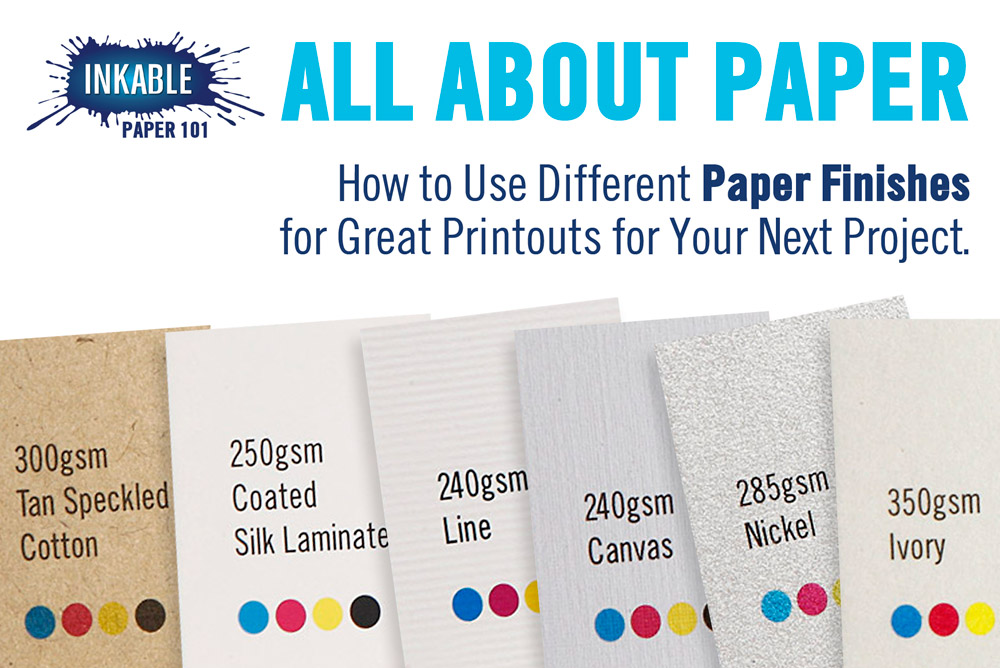All About Paper: How to Use Different Paper Finishes for Great Printouts!
- Oct 8, 2013
- 0
- Instruction, Reference, The Spill Blog
 ↑ INKABLE PAPER 101: HOW TO USE DIFFERENT PAPER FINISHES FOR GREAT PRINTOUTS!
↑ INKABLE PAPER 101: HOW TO USE DIFFERENT PAPER FINISHES FOR GREAT PRINTOUTS!
Hello, again!
Whew, another week has gone by! We hope you enjoyed All About Paper: Your Guide to Paper Sizes!, Part 2 of our Paper 101 series…Keep it bookmarked for future reference!
Moving on—today is all about paper “finishes”. And, yeah, there is more than one!
Whaddya say? Paper is paper? Well, if you’re a print advocate like us, the type of paper finish really does make a mucho difference. Don’t waste a perfectly awesome design and good money by printing on the wrong paper.
It’s a quick read. Trust us, you’ll be happy when you’ve finally decided on The One.
PAPER FINISHES
The “finish” of a certain paper describes how paper looks like and what processes it has been subject to. This is done while the paper is manufactured in the paper mill, and is determined by the paper’s surface texture and appearance. Paper finish is not the same as paper coating. It is good to note that “paper finish” applies to both coated and uncoated paper stock!
The most common types of paper finishes are:
•Wove/Bond/Vellum Finish: Think of this as “ironed paper”. Commonly used for general printing purposes, these are different standard smooth finishes. This type of finish is achieved by passing paper through sets of rollers to smoothen and level out both of its sides.
GREAT FOR: Business Forms, Booklets, Brochures
•Cast Coated/Metallic Finish: These are slick finishes generally achieved through a coating process. Metallic finishes are achieved through a thin film with pigments and sheen that simulate metal. A Cast Coated finish is paper that is coated and then allowed to harden while still in contact with a shiny chrome surface. These finishes provide the highest gloss surface of all coated boards and papers.
GREAT FOR: Premium Business Cards, Presentation Folders, Labels, Cartons
•Embossed/Linen/Felt/Laid: These types of textured finishes are produced by etched cylinders that create different patterns once paper is passed through it. Embossed paper shows a molded appearance that can dictate different finishes based on the specific patterns seen on a paper’s surface. Linen finish simulates linen cloth’s texture and appearance. Felt finishes are achieved by running paper through cylinders with various felt patterns. Laid finish is characteristic of the simple lines running the length of the paper’s surface.
GREAT FOR: Specialty Business Cards, Event Invitations, Notecards, Compliment Slips
•Calendered Glossy Finish: This type of finish is produced by using large steel cylinders (called Calendar Stacks) to tightly press paper and run it through the glazing process. Calendering can be done to either coated or uncoated paper to add a level of smoothness and shine.
GREAT FOR: All full-colour prints
•Calendered Matte Finish: Similar to Gloss, a Matte finish is achieved by running paper through cylinders to smoothen out both surfaces. In this case, paper is not as tightly pressed so that a rougher, less shiny finish is produced.
GREAT FOR: Most printed communications, bonzer for text readability
•Calendered Silk Finish: This type of finish looks very similar to Matte. Silk offers a nice range, for subdued colour. It allows for high readability and high image quality.
GREAT FOR: Special projects that feature photos and text in almost equal measure, such as Brochures, Catalogues, and Booklets.
TO RECAP:
So…What is the key to a successful printed piece? Think of the goals of your flyer, poster, business card, or brochure:
•SUITABLE PAPER FINISH: Purchasing the stock with the most appropriate paper finish will allow you to make them really handy and fit the image of the business or event that they are promoting. Plan ahead: Will you be writing on them? Textured paper such as Linen might distort your written notes. Are you printing photographs? A Gloss finish does allow for better contrast and projects vibrant colours.
We hope Part 3 of our Paper 101 series has given you a lot of helpful insights that you can apply to get that perfect catalogue, poster, or flyer for your next project.
Till the next! Ta muchly!
Ink splat,
INKABLE
P.S. Check out All About Paper: Paper Weights and Different Paper Types, Explained. Part 1 of Inkable’s Paper 101 Series and learn more about different paper types and how to interpret paper weights.
See you next time; and don’t forget to SUBSCRIBE!


